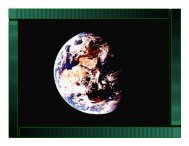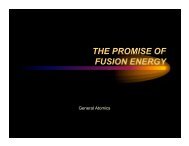Workbook: Fusion Natures Fundamental Energy Source - General ...
Workbook: Fusion Natures Fundamental Energy Source - General ...
Workbook: Fusion Natures Fundamental Energy Source - General ...
You also want an ePaper? Increase the reach of your titles
YUMPU automatically turns print PDFs into web optimized ePapers that Google loves.
<strong>Fusion</strong> <strong>Workbook</strong><br />
B<br />
a<br />
c<br />
k<br />
g<br />
r<br />
o<br />
u<br />
n<br />
d<br />
I<br />
n<br />
f<br />
o<br />
r<br />
m<br />
a<br />
t<br />
i<br />
o<br />
n<br />
Why the Difficulties in Achieving <strong>Fusion</strong>?<br />
The answer lies within the atom itself.<br />
Practically all physical matter on earth is<br />
composed of one of the three ‘common’<br />
states of matter — solid, liquid, or gas.<br />
In these states electrons revolve around<br />
nuclei composed of neutrons and protons.<br />
In the rest of the universe, however,<br />
by far the most common state of<br />
matter is plasma: the fourth state of<br />
matter. Within a plasma, electrons are<br />
PLASMA<br />
GASES<br />
LIQUIDS<br />
SOLIDS<br />
50-200 Million°K <strong>Fusion</strong> on Earth!<br />
15 Million°K Center of Sun<br />
100,000°K Atoms Lose Their Electrons<br />
6000°K Surface of Sun<br />
1800°K Iron Melts<br />
373°K Water Boils<br />
273°K Ice<br />
0°K Absolute Zero<br />
Fig. 9 - <strong>Fusion</strong> on<br />
earth requires<br />
termperatures<br />
greater than the sun<br />
free to move independent of the nucleus<br />
and the gas is essentially a sea of<br />
charged particles. More than 99% of<br />
our visible universe is in a plasma state.<br />
Producing plasmas on earth is a difficult<br />
proposition; it takes temperatures in<br />
excess of 10 thousand degrees Kelvin<br />
(10,000 K). The fusion process requires<br />
even higher temperatures. For instance,<br />
the sun’s plasma is at temperatures in<br />
E = mc 2<br />
Einstein’s equation that equates energy and mass<br />
E = <strong>Energy</strong><br />
m = Mass<br />
c = Speed of Light (3 x 10 8 m/sec)<br />
Example:<br />
If a 1 gram raisin was converted completely into energy:<br />
E = 1 gram x c 2<br />
= (10 -3 kg) (3 x 10 8 m/sec) 2<br />
= 9 x 10 13 joules<br />
This would be equivalent to 10,000 tons of TNT!<br />
Fig. 10 - As Einstein's equation indicates, the small<br />
amount of matter "lost" during a fusion reaction is converted<br />
into an enormous amount of energy.<br />
excess of 10 million Kelvin and is<br />
sufficient to cause the positively charged<br />
hydrogen nuclei to overcome their natural<br />
electric repulsion and, through a series<br />
of steps, fuse together to form helium.<br />
Without the extremely high density of<br />
the sun, temperatures almost 10 times<br />
hotter or 50 to 200 million Kelvin are<br />
needed to sustain the fusion reaction<br />
on earth.<br />
Where Does <strong>Fusion</strong> <strong>Energy</strong> Come From?<br />
Like the fission, the fusion reaction<br />
converts mass to energy. In the deuterium-tritium<br />
reaction, mass of the<br />
resulting helium and neutron are less<br />
than the initial reactants. The mass loss<br />
is only 38 parts out of 10,000; however,<br />
as Einstein’s famous equation E=mc 2<br />
indicates, even a small amount of<br />
matter can produce enormous<br />
amounts of energy (Fig 10).<br />
http://<strong>Fusion</strong>Ed.gat.com<br />
8<br />
QTYUIOP




